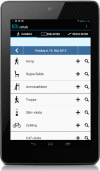Tablet computers to support outpatient pulmonary rehabilitation in patients with COPD
- PMID: 27225598
- PMCID: PMC4880620
- DOI: 10.3402/ecrj.v3.31016
Tablet computers to support outpatient pulmonary rehabilitation in patients with COPD
Abstract
Background: A minicomputer (tablet) with instructions and a training diary has the potential of facilitating adherence to pulmonary rehabilitation (PR).
Objective: To evaluate the effect of adding a tablet to a classic outpatient PR programme for COPD patients.
Methods: A total of 115 patients participated in a 7- to 10-week outpatient PR programme in groups of 10-12 individuals. Half of the groups were assigned to PR plus a tablet (tablet group) and the other groups were assigned to PR only (controls). Primary effect parameters were endurance shuttle walk time (ESWT) and disease-specific health status (COPD Assessment Test=CAT).
Results: The change in ESWT was significantly better in the control group (mean 167 sec) compared with the tablet group (mean 51 sec) (p<0.01), whereas the change in CAT score did not differ significantly between the two groups (-0.6 vs. -2.3) (p=0.17).
Conclusions: Compared with usual PR, no significant improvements were seen in the group equipped with the tablet after 7-10 weeks of rehabilitation. Future studies should focus on long-term effects.
Keywords: COPD; outcome; pulmonary rehabilitation; quality of life; technology; telemonitoring.
Figures





References
-
- Lacasse Y, Maltais F, Goldstein RS. Pulmonary rehabilitation: an integral part of the long-term management of COPD. Swiss Med Wkly. 2004;134:6s01–5. - PubMed
-
- Lange P, Brondum E, Bolton S, Martinez G. Rehabilitation of patients with chronic obstructive pulmonary disease. Ugeskr Physicians. 2005;167:274. - PubMed
-
- Hayton C, Clark A, Olive S, Browne P, Galey P, Knights E, et al. Barriers to pulmonary rehabilitation: characteristics that predict patient attendance and adherence. Respir Med. 2013;107:401–7. - PubMed
-
- Ringbæk T, Martinez G, Lange P. The long-term effect of ambulatory oxygen in normoxaemic COPD patients: a randomized study. Chron Respir Dis. 2013;10:77–84. - PubMed
-
- Effing T, Monninkhof EM, van der Valk PDLPM, van der Palen J, van Herwaarden CLA, Partidge MR, et al. Self-management education for patients with chronic obstructive pulmonary disease. Cochrane Database Syst Rev. 2007;4:CD002990. - PubMed
LinkOut - more resources
Full Text Sources
Other Literature Sources
Research Materials
Miscellaneous
